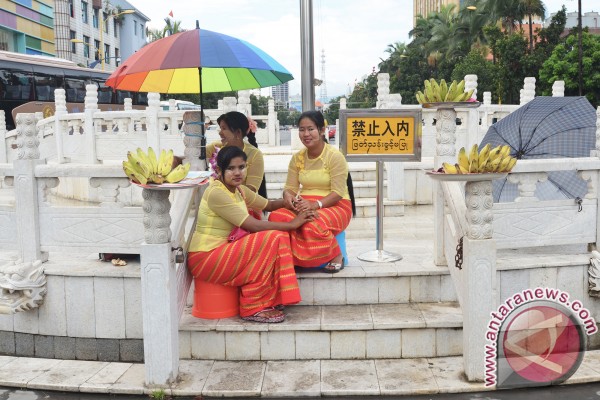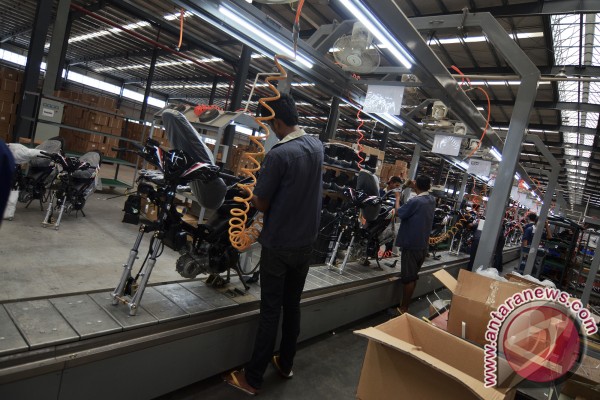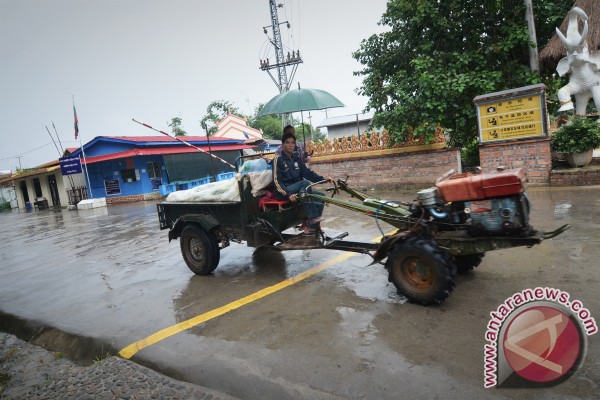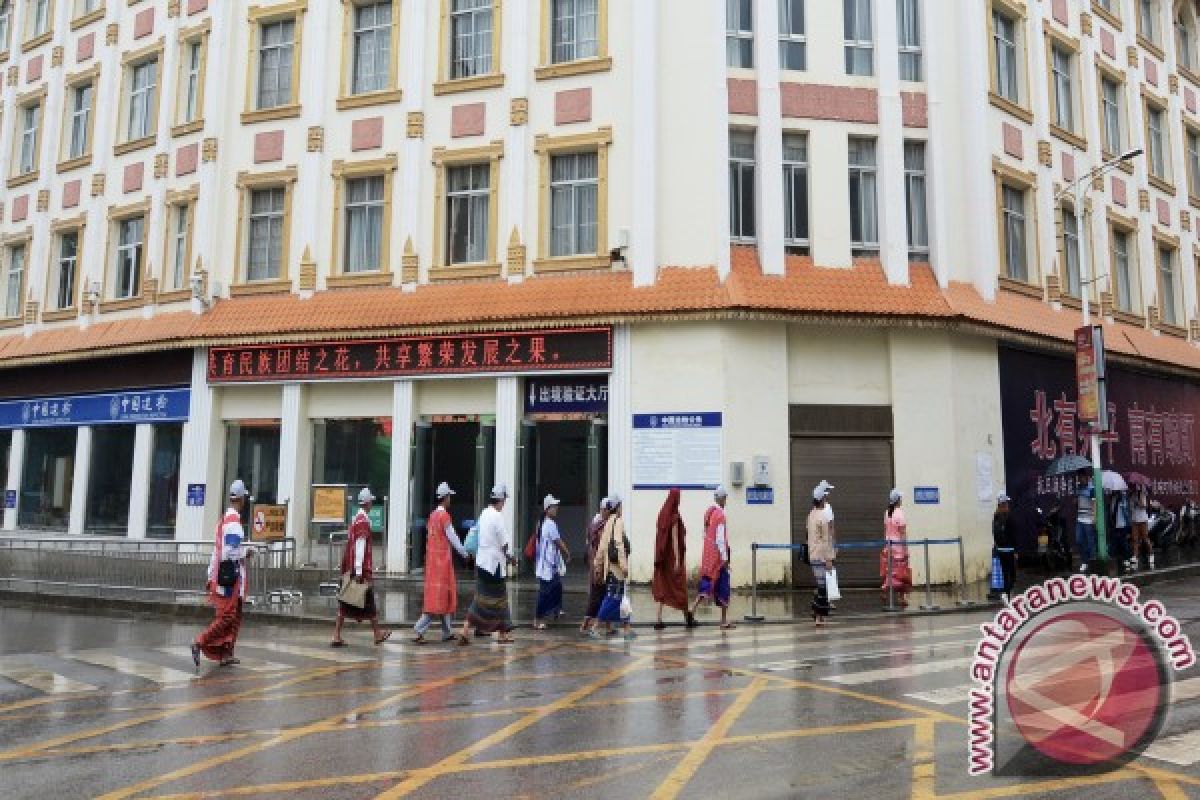Within the jurisdiction of Dehong Prefecture in the western part of Yunnan Province of China, Ruili has become a major border crossing and a strategic location for trade between China and Myanmar.
In ancient times, Ruili once was a vital gate to the ancient Silk Road at the southwest of China. Thus, the two regions are strongly connected in terms of minority culture, trade, and spiritual history.
The city, however, is only accessible over land, while the nearest airport is located in Mangshi, the capital of Dehong, some 100km to the east.
At the end of October, a group of 15 journalists from ASEAN member countries, during a media tour of the 21st Maritime Silk Road, organized by China Report and ASEAN-China Centre, had to first take a three-hour flight from Kunming, capital city of Yunnan Province, to Mangshi before continuing their journey by road to Ruili.
The mix of Chinese and Myanmar cultures was easily apparent upon entering Yunnans southwesternmost region.
A number of Buddhist temples with golden bell-shaped stupas sat at the top of a hill or at the center of villages along the road trip from Mangshi to the historical city of Ruili.

Tourists come to visit the historical Jiegao Port of Ruili in Yunnan Province of China on Thursday (Oct 27). Ruili City, which shares border with Myanmar, becomes China's southwestern gate to Southeast and South Asia. (Antara/Aditya E.S. Wicaksono)
Billboards written both in Chinese and Burmese letters had been installed on commercial or official buildings on the streets of the city, known for its cultural and ethnic diversity.
These days, the plain open terrain, improved road access, and flourishing business activities have made Ruili, a city of some 180 thousand residents, an open gate to Southeast Asia and South Asia.
The two national first-class ports of Ruili and Wanding, a town located 26km to the east, serve as two main gates and checkpoints that have boosted trade between the two countries.
Historically, Wanding Port, during World War II, became the only passageway on land and the nearest gate to the Indian Ocean, through which military supplies were carried to the interior of the country.
The port is continuing its active service with the introduction of another bridge, built at the side of the historical Wanding Bridge.
The bridge has become a local attraction for tourists who want a glimpse of the frontier or to buy duty-free products and Burmese precious jade at shops around Wanding port.
Public vehicles and trucks transporting goods from the two countries pass through the gates in Wanding and Ruili every day.

Several trucks are passing through Wanding Port in Ruili, Yunnan Province of China on Thursday (Oct 27). Wanding, which shares border with Myanmar, becomes China's southwestern gate to Southeast and South Asia. (Antara/Aditya E.S. Wicaksono).
While Chinas main export commodities to its neighboring country are daily necessities, machinery, electronics, and motorcycles, Myanmar sends its best natural resources, such as fresh fruit, vegetables, and fish, to China through these ports.
The local authority has made improvements to expedite customs clearance and avoid long queues of vehicles and trucks at the Joint Check Centre of Ruili Port, through which some four million vehicles and nearly 18 million people passed in 2015.
Deputy Chief of Industry and Commerce Bureau of Ruili Yang Hongliang noted that in 2014, it took an hour to finish each custom clearance.
"Now, it only takes 15 minutes, while fresh seafood and fruit can pass the checkpoint within five minutes," Yang stated.
Since then, the volume of Chinas exports to Myanmar has surged, earning US$4.5 billion last year.
Gate of Opportunity

Local people sit waiting for visiting tourists at the historical Jiegao Port of Ruili in Yunnan Province of China on Thursday (Oct 27). Ruili City, which shares border with Myanmar, becomes China's southwestern gate to Southeast and South Asia. (Antara/Aditya E.S. Wicaksono)
The gate of Ruili is not only open for trade but also allows thousands of Burmese people to find jobs in China.
Burmese men wearing traditional sarong-like outfits and women wearing Thanaka, a yellowish-white cosmetic paste, smeared on their cheeks are a daily sight in the downtown streets of Ruili.
Since 2013, the Chinese government has issued some 50,000 registration certificates as a permit for the Burmese people to work in Ruili and the developing zone around it.
The Foreign Service and Administration Center of Ruili City is always busy providing services to Burmese workers who want to obtain or renew this work license.
Director of Foreign Service and Administration Center of Ruili City Shao Yongbao said the office could issue 100 certificates per day to foreign workers.
"The certificate is renewable for one year. It costs 200 yuan for the service," Shao stated.
While this amounts to a single days wages for a Chinese worker, Burmese laborers receive only 100 yuan (some $14) per day.

Foreign workers queue up in front of the Foreigners Service and Administration Center of Ruili City, Yunnan Province, China on Thursday (Oct 27). The Government of China Since 2013 has issued around 50,000 registration certificate, a permit for foreigners, mostly are Burmese people, to work in Ruili and the developing zone around it. (Antara/Aditya E.S. Wicaksono)
The booming industries in Ruili have great appeal for Burmese people across the border who want to improve their lives.
"I have been working in Ruili for seven years," Burmese Mim Min Soe claimed while waiting in line at the office.
In another case, the father of a Burmese girl works nine hours per day as a courier or porter and gets paid 120 yuan daily.
The Chinese government, on a trial basis, also provided training to the foreign workers in Ruili through several education centers.
The foreigners are given at least seven days of education and training in daily conversational skills, local laws, and healthcare before they start work.
The Yunnan Technical College, Ruili Branch, is one of the authorized education centers providing international vocational training in Ruili.
"Employees who do not have the necessary language skills and certain professional skills need to know more about Chinese law and customs. They need to get used to living here," the director of the college in Ruili, Luo Hailin, stated.
Once they have the necessary skills, the Burmese people start working in various sectors, such as construction, maintenance, cleaning services, and manufacturing, in Ruili.

Workers, mostly Burmese people, assemble motorcycle parts in the Yinxiang Motorcylce's assembly plant in Ruili, Yunnan Province of China on Thursday (Oct 27). (ANTARA/Aditya E.S Wicaksono)
Yinxiang Motorcycle is one of the largest manufacturers in Ruili and requires skilled workers for its three assembly plants. Some 70 percent of its employees are Burmese, and the company is able to produce 800 motorcycles per day per assembly line.
One Village in Two Countries
In a small village some 10 km from downtown Ruili, villagers from the two countries have been living in harmony, side by side, for generations.
There is no separating wall at the border; only a painted yellow line on the ground dividing the two neighborhoods of Dai Village.
The village of the Dai minority is known as "One Village in Two Countries" since the border splits the whole village into two: The Chinese section is called Yinjing and is inhabited by some 1.4 thousand residents, while the Myanmar section is called Mangxiu, with some one thousand residents.
Villagers of the two countries speak the same language and share the same costumes and traditions.

Local resident drives a tractor crossing the borderline in Dai Village, Ruili, Yunnan Province of China on Thursday (Oct 27). The village of Dai minority is known as One Village in Two Countries since the borderline splits the whole village into two parts, one in China is called Yinjing, and the other in Myanmar called Mangxiu. (Antara/Aditya E.S. Wicaksono)
Exchanges between the two sides are a daily routine in the village, which is also home to several shops selling handicrafts and Burmese jade as souvenirs to visiting tourists.
Since the village has no natural boundary, it is not surprising to see vegetables growing on Chinese soil bearing fruit on the Burmese side. Local farmers are even seen freely driving their tractors across the frontier gate to cultivate their land on the other side of the village.
The balance of control and flexibility in Dai Village can be an example to other countries.
While the loose border control has helped maintain social interactions and contributed to the economy of the local community, an unnecessary tightening of security would only disrupt the diverse ethnic community at the border.
Reporter: Aditya E.S Wicaksono
Editor: Ida Nurcahyani
Copyright © ANTARA 2016












